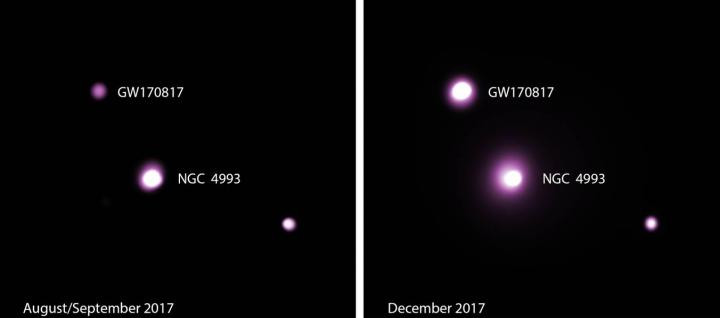Mysterious glow from distant Kilonova neutron star collision baffles scientists
The afterglow from the massive collision has continued to brighten up since August 2017.
Remember the two neutron stars that were found merging some 138 million light-years away from Earth last August? Researchers looking at the aftermath of that collision, officially dubbed GW170817, have witnessed something mysterious.
In regular explosions, a bright flash appears and then fades away. Researchers expected to see something similar at the cosmic level from the neutron star smash-up — commonly known as Kilonova — but, recent observations by Nasa's Chandra X-ray Observatory have revealed something different.
The gamma-ray, or intense bright light, bursting from the merger of the two neutron stars has continued to brighten up over the past four months, according to the study, published in Astrophysical Journal Letters.
"Usually when we see a short gamma-ray burst, the jet emission generated gets bright for a short time as it smashes into the surrounding medium - then fades as the system stops injecting energy into the outflow," says Daryl Haggard, whose research group led the new study.
"This one is different; it's definitely not a simple, plain-Jane narrow jet."
X-ray and optical observatories first measured the gamma-ray burst in the month of September 2017 but, they could not continue the work for three months because the object in question was too close to the sun in the sky, which would have affected the measurements.
The radio data, however, kept showing the gradual increase in brightness, which was further confirmed in December 2017 when researchers took another look at the object, witnessing a significant increase in its brightness since August/September last year.

The researchers are not really sure about the cause of this weird behaviour but, the group posits maybe a high-energy jet outflow from the collision has shock-heated the debris surrounding the newly formed object, forming something like a "cocoon" that has been glowing all this time.
The group will conduct further observations to build on the latest findings and decode the mystery behind the increasing brightness. "This neutron-star merger is unlike anything we've seen before," says Melania Nynka, another author of the study. "For astrophysicists, it's a gift that seems to keep on giving."
The event had sent gravitational waves rippling through the universe, allowing astronomers to directly witness the merger of the two collapsed stars — something that has never been witnessed before.





















